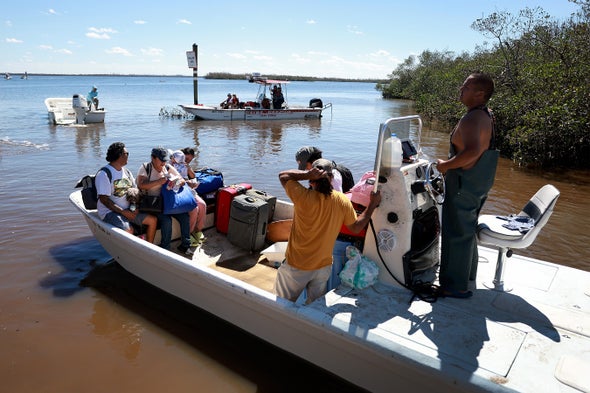More than three million adults were forced to evacuate their homes in the U.S. in the past year because of hurricanes, floods and other disasters, according to the Census Bureau

The center’s figures include an estimated 1.7 million people displaced in 2017, which saw three of the most destructive storms in U.S. history — hurricanes Harvey, Irma and Maria.
“These [census] numbers are unbelievable,” said Hannah Perls, an attorney at Harvard Law School’s Environmental & Energy Law Program. The census figures suggest that “international data and reporting severely underestimate the number of IDPs,” or internally displaced persons, Perls said.
Most displacements were short term, according to the Census Bureau, which reports that nearly 40 percent of people returned home within a week of evacuating.
But the census figures also show that roughly 16 percent of the displaced adults never returned home and 12 percent were out of their homes for more than six months. Many people who face permanent displacement have disabilities, which lead to hardships after disasters such as isolation and food shortages (Climatewire, Jan. 6).
The census figures reflect higher rates of long-term and permanent displacement than other research has shown, said Carlos Martín, a Brookings Institution scholar and expert on disasters.
“Hurricanes tend to have very widespread damages that lead to longer displacement times,” Martín said in an email. About half of the displacements resulted from hurricanes, census figures show.
Martín said the total number of displacements “are not that surprising given the number of disasters this past year.”
The census estimate appears to be more comprehensive than the international center estimate, though the Census Bureau cautions that its figures are “experimental.”
The Census Bureau count is based on 68,500 responses it received between Jan. 4 and Jan. 16 to online surveys that asked dozens of questions including whether the respondent had been displaced from home due to a disaster in the preceding 12 months. The surveys were part of the Household Pulse Survey, which the bureau started in 2020 to measure how the coronavirus pandemic was affecting the U.S. population.
The international center relies on information from government and civil sources such as the Federal Emergency Management Agency and the American Red Cross. The scope could limit the center’s analysis to major disasters that involve FEMA and the Red Cross and exclude smaller events.
The Census Bureau’s data shows that people were displaced by disasters in every state in 2022, including 29 states that did not have a major disaster involving FEMA.
In Louisiana, 11 percent of the state’s adults — nearly 370,000 people — were displaced due to a disaster in 2022. That is by far the highest rate of any state and well ahead of second-place Florida, where 5 percent of adults were displaced.
Louisiana did not experience a major disaster in 2022, although large parts of the state remain damaged by Hurricane Laura in 2020 and Hurricane Ida in 2021. Florida was devastated in 2022 by Hurricane Ian, one of the most destructive storms in U.S. history.
The census figures also show:
- The lowest-income households — those earning less than $25,000 a year — had the highest evacuation rate of any economic group, and evacuation rates were generally lower for wealthier households. Census figures show that 3.5 percent of the lowest-income households faced evacuation compared with 1.1 percent of households with income above $200,000.
- Gay, lesbian and transgender people had much higher evacuation rates than people who are straight or cisgender. Nearly 4 percent of gay or lesbian people evacuated compared with 1.2 percent of straight people.
- The evacuation rate for people who are divorced or separated was twice as high as the rate for married people, with 2.2 percent of divorced or separated people evacuating compared with 1 percent of married people.
- Black and Hispanic residents had slightly higher evacuation rates than white residents.
Perls of Harvard Law said she hopes federal and state officials analyze the census data to grasp the “sheer scope and scale of displacement” and the needs of people who face longer evacuations and more severe hardship due to being displaced.
ABOUT THE AUTHOR(S)
Thomas Frank covers the federal response to climate change for E&E News.


